Szybka witryna internetowa jest niezbędna dla zadowolonych odwiedzających i najwyższych pozycji w wyszukiwarkach. Dzieje się tak, ponieważ wyszukiwarki takie jak Google uważają teraz szybkość witryny za ważny czynnik rankingowy.
WP Super Cache to popularna wtyczka, która tworzy statyczne pliki HTML twoich stron internetowych. Oznacza to, że twój serwer nie musi pracować tak ciężko, dzięki czemu witryna wczytuje się szybciej dla odwiedzających.
Używamy wtyczek wydajnościowych, takich jak Cloudflare i WP Rocket, aby poprawić szybkość WPBeginner. WP Super Cache to darmowa alternatywa, która może znacznie poprawić wydajność, zwiększyć SEO i poprawić wrażenia użytkowników odwiedzających witrynę internetową.
W tym artykule przeprowadzimy cię przez proces instalacji i konfiguracji WP Super Cache na twojej witrynie WordPress. Wyjaśnimy każdy krok w jasny sposób, więc nawet jeśli nie jesteś obeznany z technologią, możesz podążać za nami. Pod koniec będziesz mieć szybszą witrynę internetową, którą docenią odwiedzający i wyszukiwarki.
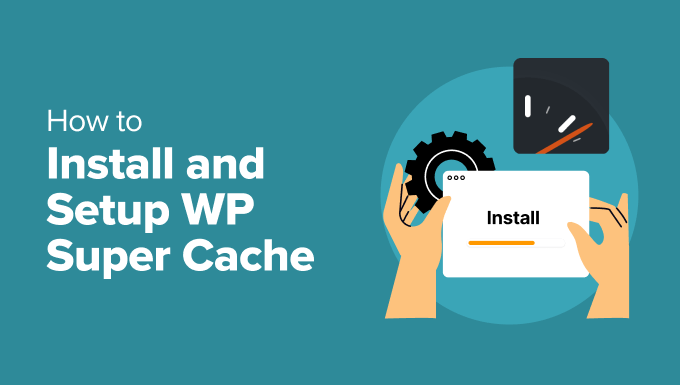
Czym jest WP Super Cache i dlaczego warto z niego korzystać?
WP Super Cache to jedna z najpopularniejszych i najlepszych wtyczek do pamięci podręcznej WordPress. Jest to darmowe narzędzie, które ma ponad milion włączonych aktywnych instalacji.
WP Super Cache tworzy podręczną kopię każdej strony w twojej witrynie w postaci statycznego pliku HTML. W ten sposób za każdym razem, gdy ktoś przejdzie na twoją witrynę, zostanie mu szybko wyświetlona skopiowana wersja, zamiast generować całą witrynę od zera.
W rezultacie szybkość i wydajność twojej witryny WordPress znacznie się poprawiają. Wtyczka pamięci podręcznej pomija wiele kroków za kulisami, aby zapewnić, że twoi odwiedzający nie będą musieli czekać na otwarcie strony.
Poprawi to wrażenia odwiedzających twoją witrynę internetową. Witryna, która wczytuje się szybko, zachęca ludzi do częstszego jej odwiedzania, co prowadzi do większego zaangażowania i konwersji, ponieważ użytkownicy spędzają więcej czasu na twoich wpisach i stronach.
Poza tym, dzięki szybko ładującej się witrynie internetowej, możesz również zobaczyć wzrost Twojego WordPress SEO i rankingów wyszukiwarek. Dzieje się tak, ponieważ Google daje znaczną przewagę szybszym witrynom internetowym, ponieważ wykorzystuje szybkość witryny jako czynnik rankingowy.
Czy jesteś już gotowy, aby skonfigurować WP Super Cache na swojej witrynie internetowej? Do dzieła!
Konfiguracja pamięci podręcznej WP Super Cache – prosty sposób
Pierwszą rzeczą, którą musisz zrobić, to zainstalować i włączyć wtyczkę WP Super Cache na twojej witrynie internetowej. Aby uzyskać więcej informacji, możesz skorzystać z naszego przewodnika na temat instalacji wtyczki WordPress.
Po włączaniu, WP Super Cache powiadomi cię, że pamięć podręczna nie jest włączona na twojej witrynie internetowej w danym momencie.
Aby włączyć pamięć podręczną, przejdź do Ustawienia ” WP Super Cache. Następnie na karcie “Łatwe” kliknij opcję “Włącz pamięć podręczna”. Gdy to zrobisz, kliknij przycisk “Aktualizuj status”.
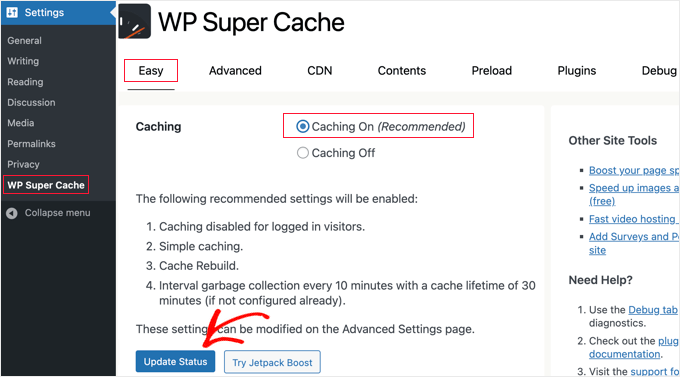
Po włączeniu pamięci podręcznej należy przewinąć w dół do sekcji “Tester pamięci podręcznej”.
Tam należy kliknąć przycisk “Testuj pamięć podręczna”, aby sprawdzić, czy działa.
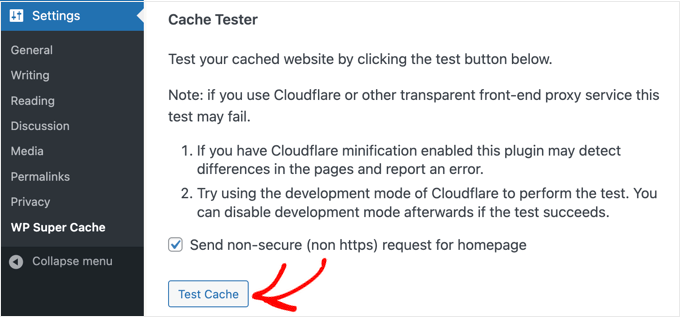
WP Super Cache pobierze twoją witrynę WordPress dwa razy i porówna znaczniki czasu obu stron. Jeśli oba znaczniki czasu są zgodne, oznacza to, że pamięć podręczna działa teraz na twojej witrynie.
Zaawansowana konfiguracja WP Super Cache
WP Super Cache to potężna wtyczka WordPress z mnóstwem zaawansowanych opcji. Opcje te mogą jeszcze bardziej poprawić wydajność twojej witryny i dać ci większą kontrolę nad tym, jak wtyczka zapamięta podręczną twoją witrynę.
Włącz pamięć podręczna
Aby skonfigurować WP Super Cache z zaawansowanymi opcjami, przejdź do karty “Zaawansowane” w ustawieniach wtyczki WP Super Cache. Następnie kliknij pole wyboru “Włącz pamięć podręczną”.
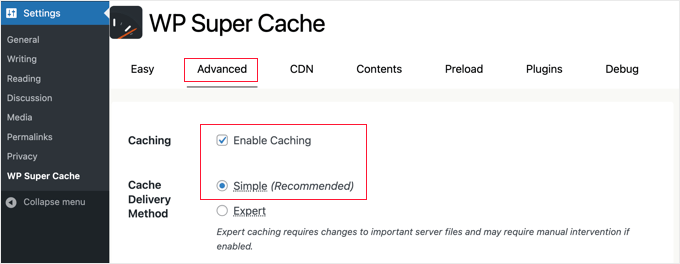
Poniżej opcji pamięci podręcznej znajdują się opcje “Metoda dostarczania pamięci podręcznej”. Zalecamy skorzystanie z opcji “Simple”, jeśli jesteś początkującym użytkownikiem i nie znasz się na edycji plików twojego serwera.
Po wybraniu twojej opcji pamięci podręcznej, upewnij się, że kliknąłeś przycisk “Aktualizuj status”.
Włącz kompresję w WP Super Cache
Kompresja pozwala WP Super Cache obsługiwać pliki w pamięci podręcznej jako pliki skompresowane, co poprawia czas ich wczytywania. Pliki te są mniejsze i mogą być szybciej pobierane przez przeglądarki.
Aby włączyć kompresję, przewiń w dół do sekcji “Różne” na karcie ustawień “Zaawansowane” i zaznacz pole “Kompresuj strony, aby były szybciej wyświetlane odwiedzającym”.

Ponownie kliknij przycisk “Aktualizuj status”, aby zapisać twoje zmiany.
Włącz dynamiczną pamięć podręczna
Jeśli chcesz, aby niektóre części strony internetowej były dynamiczne podczas pamięci podręcznej, WP Super Cache oferuje taką opcję.
Włączenie dynamicznej pamięci podręcznej jest przydatne w niektórych sytuacjach, zwłaszcza w przypadku stron zawierających często zmieniającą się treść. Na przykład, możesz przyspieszyć strony zawierające reklamy, zezwalając na dynamiczną pamięć podręczna.
Aby włączyć tę opcję, należy przejść do sekcji “Zaawansowane” i kliknąć pole wyboru “Włącz dynamiczną pamięć podręczna”.

Pamiętaj, aby zapisać twoje zmiany po zakończeniu.
Konfiguracja czasu wygaśnięcia i zbierania śmieci
WP Super Cache pozwala również ustawić czas wygaśnięcia i częstotliwość usunięcia pamięci podręcznej stron z twojego serwera.
Aby rozpocząć, wystarczy przewinąć w dół do sekcji “Expiry Time & Garbage Collection” w karcie “Advanced”, aby ją skonfigurować.
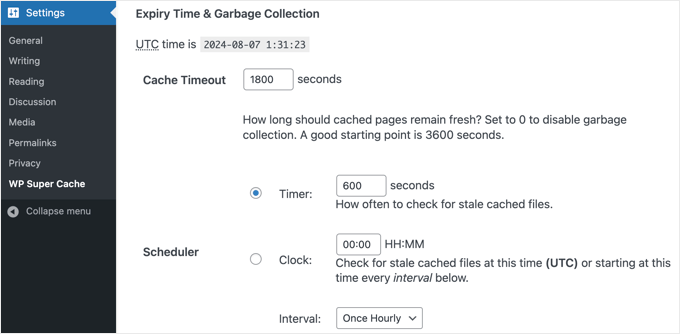
“Cache Timeout” informuje wtyczkę, aby usuwała stronę z pamięci podręcznej i wykonywała nową pamięć podręczną. Wtyczka domyślnie ustawi go na 1800 sekund, co jest świetnym rozwiązaniem dla witryn internetowych o dużym natężeniu ruchu.
Jeśli jednak masz nową witrynę internetową, która nie ma dużego ruchu, to 3600 sekund jest dobrym punktem wyjścia.
Poza tym można zaplanować czas, w którym wtyczka będzie sprawdzać nieaktualne pliki w pamięci podręcznej i usuwać je.
Po zakończeniu dokonywania wyboru należy kliknąć przycisk “Zmień wygaśnięcie”, aby zapisać twoje zmiany.
Określ strony, które nie mają być zapisywane w pamięci podręcznej
Domyślnie wtyczka będzie buforować wszystkie strony w twojej witrynie. Może to zwiększyć rozmiar twoich plików pamięci podręcznej i zużywać więcej zasobów. WP Super Cache pozwala jednak wybrać strony, które nie mają być buforowane.
Możesz przewinąć w dół do sekcji “Odrzucone ciągi adresów URL” na karcie “Zaawansowane”, aby skorzystać z tej funkcji. W polu tekstowym wpisz adres URL stron, których pamięć podręczna nie ma być buforowana przez wtyczkę.
Na przykład, jeśli posiadasz sklep e-handel, możesz wykluczyć strony, na które odwiedzający nie przechodzą zbyt często, oszczędzając w ten sposób zasoby serwera. Może to być strona kasy, strona konta i strona z podziękowaniem.
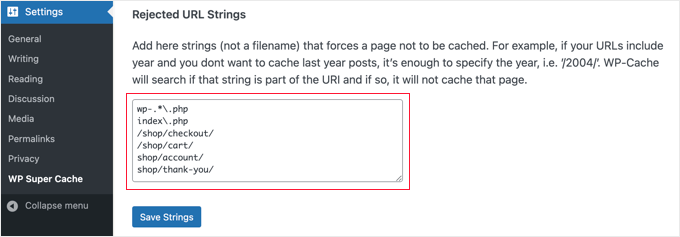
Po zakończeniu nie zapomnij kliknąć przycisku “Zapisz ciągi”.
Konfiguracja pamięci podręcznej WP Super Cache do pracy z twoim CDN
Jeśli korzystasz również z usługi Content Delivery Network (CDN), aby przyspieszyć twoją witrynę internetową, możesz skonfigurować WP Super Cache do współpracy z nią. W przeciwnym razie możesz bezpiecznie pominąć tę sekcję.
CDN to sieć serwerów rozmieszczonych w różnych lokalizacjach geograficznych, która pomaga szybko dostarczać treści twoim odwiedzającym. Aby uzyskać więcej informacji, zapoznaj się z naszą infografiką na temat tego, dlaczego potrzebujesz CDN.
Wskazówka: Zalecamy korzystanie z Cloudflare, ponieważ jest to darmowy dostawca CDN, który jest łatwy w konfiguracji. Zobacz nasz poradnik, jak skonfigurować darmową sieć CDN Cloudflare na twojej witrynie WordPress.
Aby skonfigurować WP Super Cache do pracy z twoją siecią CDN, kliknij kartę CDN w ustawieniach. Następnie zaznacz pole obok opcji “Włącz pomoc techniczną CDN”.
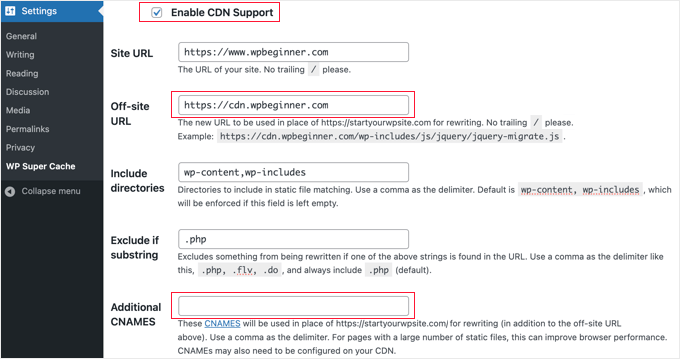
Następnie wpisz swój adres URL poza witryną. Jest to “strefa pobierania” twojego CDN, czyli adres URL, pod którym twoje pliki są przechowywane w CDN.
Ustawienia tutaj zależą od twojej usługi CDN, ale oto kilka wskazówek:
- Jeśli korzystasz z Cloudflare, pozostaw to pole puste. WP Super Cache automatycznie wykryje i będzie współpracować z Cloudflare.
- Jeśli korzystasz z innej usługi CDN, wpisz coś w stylu: https:
//cdn.wpbeginner.com.Upewnij się, że zastąpiłeś “wpBeginner.com” nazwą domeny twojej witryny internetowej. - W razie wątpliwości można logować się do usługi CDN i sprawdzić ustawienia kokpitu twojego konta dla “domeny”, “domeny CDN” lub “adresu URL CDN”.
Jeśli wiesz, że twój CDN ma wiele adresów URL, możesz je wpisz w polu “Dodatkowe CNAMES”, takie jak: http: //cdn1.wpbeginner.com, http://cdn2.wpbeginner.com, http://cdn3.wpbeginner.com. W przeciwnym razie należy pozostawić to pole puste.
Pozostałe ustawienia można pozostawić domyślne. Na koniec zaznacz pole “Pomiń adresy URL https, aby uniknąć błędów “mieszanej treści””, a następnie kliknij przycisk “Zapisz zmiany”.
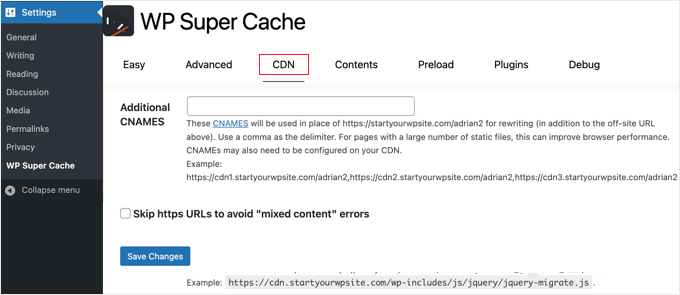
Teraz twoja witryna internetowa jest gotowa do serwowania statycznych treści z CDN.
Serwowanie witryn statycznych za pomocą WP Super Cache
Tryb wstępnego ładowania w WP Super Cache umożliwia tworzenie super pamięci podręcznej statycznych plików dla wszystkich twoich wpisów i stron oraz serwowanie statycznej witryny internetowej. W ten sposób twoje treści będą się szybko wczytywać za każdym razem, gdy ktoś przejdzie na twoją witrynę.
Plik statyczny super cache pomaga oszczędzać zasoby serwera, obsługiwać starą witrynę, która nie jest już aktualizowana, i poprawiać szybkość witryny poprzez serwowanie tylko statycznych treści.
Aby rozpocząć, przejdź do karty “Preload” we wtyczce WP Super Cache. Następnie można ustawić czas odświeżania wstępnie załadowanych plików pamięci podręcznej.
Domyślnie wtyczka ustawia ten czas na 600 minut, ale możesz go zmniejszyć, jeśli publikujesz wiele artykułów dziennie.
Pamiętaj, że wstępne wczytywanie całej witryny WordPress zajmuje trochę czasu i zużywa dużo zasobów twojego serwera. Możesz pozostawić wartość 0, jeśli nie chcesz, aby twoje pliki statyczne kiedykolwiek wygasły, chyba że ręcznie odświeżysz pamięć podręczna.
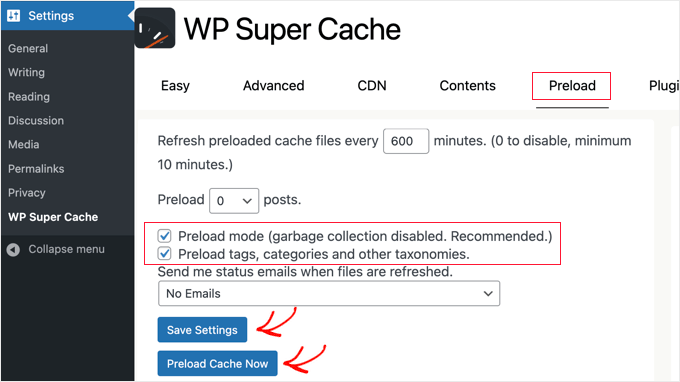
Następnie upewnij się, że zaznaczone są pola “Tryb wstępnego ładowania (wyłączone odśmiecanie. Zalecane)”. Możesz również włączyć wstępne ładowanie dla różnych tagów, kategorii i innych taksonomii w twojej witrynie internetowej.
Wtyczka oferuje również opcję otrzymywania powiadomień e-mail za każdym razem, gdy twoje pliki są odświeżane. Domyślnie używane jest ustawienie “Brak e-maila”, ale można je zmienić, wybierając opcję z menu rozwijanego.
Gdy skończysz, zapisz swoje ustawienia, a następnie kliknij przycisk “Załaduj pamięć podręczną teraz”.
Przewodniki ekspertów na temat pamięci podręcznej WordPress
Mamy nadzieję, że ten przewodnik pomógł ci skonfigurować WP Super Cache na twoim blogu WordPress. Być może spodoba ci się kilka innych artykułów związanych z pamięcią podręczną WordPress:
- Jak łatwo naprawiono ostrzeżenie o buforowaniu przeglądarki w WordPressie?
- Jak wyczyścić pamięć podręczna w WordPress (krok po kroku)
- Najlepsze wtyczki WordPress do pamięci podręcznej, aby przyspieszyć twoją witrynę internetową
- LiteSpeed Cache vs. WP Rocket – który z nich jest lepszy?
- Jak prawidłowo zainstalować i skonfigurować WP Rocket w WordPress
- Jak zainstalować i skonfigurować W3 Total Cache dla początkujących
- Najlepszy przewodnik po zwiększaniu szybkości i wydajności WordPressa
- Jak przyspieszyć wydajność WooCommerce
If you liked this article, then please subscribe to our YouTube Channel for WordPress video tutorials. You can also find us on Twitter and Facebook.





Greg
Hi, I’d like to know whether your guidance to choose mod_rewrite to serve cache files still stands as opposed to using PHP or Legacy Caching. I notice since you published your article, WP Super Cache have changed their own recommendation from mod_rewrite to PHP.
Thanks in advance!
Greg
Dillon
Hi there. I’ve followed this tutorial to a T, and for the most part, everything works correctly, but I’m having two problems. First, when I make changes, they don’t appear on the site if I’m logged in. If I log out, they appear just fine. Second, I’m working on a WPMU network, and I only have the plugin installed on one site. But it’s caching the other sites on the network as well. How do I stop it from doing that? Thanks!
Belayet Hossain
This is an awesome guideline for new users.
It helped me a lot.
Thanks from the core of heart.
Sarah
Hi,
I followed your steps because my site was taking over 5s to load but after setting up the WP Super Cache my site wouldn’t load. At all. It was basic HTML – no content, no pictures, just the header…
So, I guess I’m wondering if there’s a laymen’s guide to literally all the terms you use cause I don’t understand websites or programming and I have a website for a start-up NGO so can’t really pay for any help at this point.
Or maybe you could direct me somewhere that will help me understand all this better? I’m a complete novice and confused easily!
Help!
Pedro Moreira
Hello,
I have a “conceptual doubt” about WP Super Cache, that I didn´t see answered neither in your site neither in other sites.
The question is: the structure of my site is finished. In basic terms, it is mainly a site of videos of football, which means that from this day on I will gradually add posts (that include the videos that I refered) and pages (of the teams).
Since that this will be a long and permanent process, I need right now to speed up my site because nowadays is very slow.
My doubt is: when I install and configue this plugin, what does that mean in terms of the updates that I will do in my site (post and pages that I add)?
I mean, if I cache the site today and tomorrow I add a new page or post, what do I have to do in order that these pages or posts will be also cached? – do I just have to require an update of the plugin? If so, how do I do that, is it possible to define that the plugin will update the cache for example once a week?
Thank you!
Best regards.
Bogdan
If i don„t use set up the CDN ,the wp super cache will be work properly ?
WPBeginner Support
Yes, it will work even without CDN.
Admin
Herman
I’m getting an error on the first step where you need to click on caching on and update. You mentioned the following in your article:
“WP Super Cache will fetch your WordPress site twice and will compare the time stamps of both pages. If the both time stamps match then this means that caching is working on your site now.”
This is the place where I get the error. I get a message that says:
Fetching to prime cache: OK
Fetching first copy of FAILED
Fetching second copy of : FAILED
I would be glad if you could help me out.
Sofor
Thank you so much, It works great for me.
Teddy
My site is a coupon site, so code is included on the coupon so it prints out by itself without lots of other junk that is on the page. If I use WP Super Cache, will that code be lost because it’s now a static page? Will people still be able to click on the coupon to print just the coupon?
WPBeginner Support
Hi Teddy,
You will have to test it out first on your computer or in a staging environment.
Admin
Alex
Thanks so much for the the help. Do i have to create a cname record to use the CDN service in WP super cache. Thanks
Stefan Andonov
Hi,
How to preload for several languages, I am using qtranslate, that seems impossible, right?
10x
Stefan
John Johnson
This is an ecommerce site using Exchange from iThemes. With WP Super Cache activated certain pages that need to be refreshed don’t get refreshed i.e. Empty Cart. When you Empty Cart it comes back with the same content or in other words it appears unemptied.
When I deactivate WP Super Cache the problem disappears. It was suggested that I Whitelist the pages that shouldn’t be cached. I am uncertain about how to do that. Any help would be appreciated.
Regards,
John
Dajuan
WP Beginner Staff, when a theme update is applied, or when other plugin updates are made, is WP Super Cache alerted to create new cached versions? Or does the plugin wait until “Expiry Time & Garbage Collection” or a manual cache deletion?
Iosif
Hello,
I am using WP Super Cache, but it seems that my images don’t get cached. Any ideas on how to configure this?
I did have a lazy load plug-in, but it conflicted with my theme, so I deactivated it…
shubhendu
I have just install wp super cache plugin by reading your article but nor js,css and image is not loading at my blog…plz help my site address is
If you dont want to publish is comment because i include my site link PLEASE reply to my email id.
Thanks.
WPBeginner Support
Seems like you have already resolved the issue.
Admin
madhavi jha
hi , i am regular reader of your site , i have setup WP Super Cache plugin as you guide in your blog , but its not working its show only 20/100
please guide me ,i have been tried to solve this problem since last 2 days , please guide me .
nitai roy
Hi,
I followed as you mentioned here. Everything has done perfectly but I could not find this option: “Enable Compression in WP Super Cache:”
Where is it please?
Also, Now how can I know whether it is working perfectly or not?
Thank you very much.
Patel Shoeb
How to Install and Setup WP Super Cache with CloudFlare CDN?
kurakaniz
after updating the plugin it says “.htaccess file may need to be moved” and this error too
A difference between the rules in your .htaccess file and the plugin rewrite rules has been found. This could be simple whitespace differences but you should compare the rules in the file with those below as soon as possible. Click the ’Update Mod_Rewrite Rules’ button to update the rules.
what to do please help
Ron
Same problem here.Anyone help
stephen
I installed everything just as you said but I am still getting 52sec load time and if I tried using gtmetrix I get an error saying the URL does not appear to be an HTML.home page . please help site is
Megan Good
This article was very helpful, and I was able to troubleshoot my issues based on your suggested settings. Thank you for the info!
Omprakash Jaiswal
wp super cache does not work
Permlink Structure Error
A custom url or permalink structure is required for this plugin to work correctly. Please go to the Permalinks Options Page to configure your permalinks.
Hammad
Thank you for your suggestions, I’m trying to apply these settings on my website now. Can you please advise if wp super cache supports minify settings.
I had wp3 total cache and had a score of 97/81 on gtmetrix, after installing wp super cache my score decreased to 82/68.
Imran
Was looking for some great guide for super cache plugin. Now I will try it on my test site.
Thanks for such a nice tutorial
Robert Connor
Some great tips-now i need to go back and fix my site
User
How do I get it to work for Mobile without changing the theme?
cezars
Any info for Rejected User Agents list from the plugin ?
herb
Installed it and got a lower grade E/D on Gtmetrix…switched to W3TC and it gave me and A/B grade.
efiga
Hi
i have a little question , when using this plugin to cashe pages , the google adsense ads will be cashed too ? ,it will show the same ads ?
thank you in advance
WPBeginner Staff
No your Google Ads will not be cached.
shadow
does nothing for me
avisdupublic.net
Hi, Thank you for this outstandly good article. However, I am facing several issues with WP S. Cache.
The website is : avisdupublic.net
1°) My Home page is a static one. However, when a new article is published, the /home must be changed (new article in the slider and so on). However, it is no the case! Moreover, when I just “update” this static page, by a strange miracle (not so strange because with the update, the cache-page is flushed), the /home becomes “normal”.
2°) From 1°), I decided to tick the Pages, Front page, Is_home in the rejected ones. However no changes appeared in the /home.
Do you have an idea where could be the problem ?
Bests,
(sorry for the poor english)
Farcas Gelu Danut
I’m sorry for my poor English language.
I use now WP Total Cache, CDN is Cloudflare, shared hosting.
Specialists working at hosting company I recommend using wp super cache to replace the WPTotal Cache. What is your opinion?
WP Total Cache internet is recommended, considered superior WP Super Cache.
I use Google translate for this comment. Is OK?
WPBeginner Support
Farcas, W3 Total Cache and WP Super Cache are both good plugins.
Admin
Nguyen Duc
Thanks for post, but i have a problem below:
Warning! Could not update /home/d2c45a95/public_html/wp-config.php! WPCACHEHOME must be set in config file.
Warning! /home/d2c45a95/public_html/wp-content/advanced-cache.php does not exist or cannot be updated.
1. If it already exists please delete the file first.
2. Make /home/d2c45a95/public_html/wp-content writable using the chmod command through your ftp or server software. (chmod 777 /home/d2c45a95/public_html/wp-content) and refresh this page. This is only a temporary measure and you’ll have to make it read only afterwards again. (Change 777 to 755 in the previous command)
3. Refresh this page to update /home/d2c45a95/public_html/wp-content/advanced-cache.php
If that doesn’t work, make sure the file /home/d2c45a95/public_html/wp-content/advanced-cache.php doesn’t exist:
1. Open /home/d2c45a95/public_html/wp-content/plugins/wp-super-cache/advanced-cache.php$wp_cache_file in a text editor.
2. Change the text CACHEHOME to /home/d2c45a95/public_html/wp-content/plugins/wp-super-cache/
3. Save the file and copy it to /home/d2c45a95/public_html/wp-content/advanced-cache.php and refresh this page.
How to fix it, bro
Joe Capone
I have Super Cache working…the contents show all of the pages in the cache. It has increased our site speed.
the site is insuringincome.com
For some reason, when I enter additional cnames and use http://content1.insuringincome.com,….
Comma separated from content1-content10 (confirmed that all cnames are created in CloudFront districution)….I get a 404 error when saving.
I have tried many different settings…nothing prevents the 404 from trying to save with additional cnames.
Thoughts?
WPBeginner Support
Please checkout WP Super Cache documentation on how to set this up.
Admin
Borislav
Hi Guys!
First sorry my English, because it is not very good!
I use wordpress and Boozurk theme version 2.02.
I have a little problem and i want little help!
The problem is: when i use my phone and surfing my site, sometimes the theme not switch to mobile view and everything in my site is with wrong view.
I also use WP super cashe plugin. When i activate the cashe and continue surf the site, then the theme not switch to mobile view and show me a desktop view of the site.
When i deactivate WP super cashe plugin and delete the cashe the view of the site on my phone is perfect. The theme switch to mobile view.
Is there any settings of WP super cashe plugin that i have to make, and when i make them the people who surf my site with mobile phones or tablets,
to surf mobile view of the site, not the cashe page of desktop view.
I hope you will understand me! Thank you!
WPBeginner Support
Borislav, it seems that your theme uses php to detect mobile users and then switches the theme. When you are using WP Super Cache, it displays the standard theme from the cache, so the part where your theme detects and displays mobile theme is not executed. Your theme’s developer can help you better in this regard, or you can also try WP Super Cache’s support tab.
Admin
pipdig
Really useful, thanks! We managed to get one of our website’s loading time down from 6+ seconds to 0.8 using a combination of WP super Cache and Cloudlfare’s Rocketloader. Amazing!
Ali
by using this i wen from 82 to 92 on google page speed test thanks http://www.3maniac.com
Thomas Frenkiel
I wanted to use mod-rewrite for a website that has WordPress installed in a subdirectory.
This seemed to cause a problem (only homepage was showing). What kind of thing is best to do in this case? Is there a way to use mod_rewrite on a sub directory?
Thanks in advance.
WPBeginner Support
There could be various reasons. There could be a conflict with .htaccess file in the parent directory or a comment missing # sign in your .htaccess file. You better post in plugin’s page under support tab.
Admin
Shantanu
Hi Sir ,
Thanks for the post. I have a question , When i update or publish a post or page it does not appear on the homepage. This happens due to Wp Super Cache. Please help !
WPBeginner Support
Shantanu, you should check your wp super cache settings. If everything seems to be setup correctly then you are probably viewing a cached page from your browser.
Admin
Shantanu
Thank You , So Much for the Help! My Blog now has a Rocking Speed.
My Blog now has a Rocking Speed.
Thanks Once again!
Muhammad Waqas Baig
Hi, I have tried settings you recommended but there is not speed improvements. Can you please guide me further. I used GTMetrix and here is my blog
http://www.pakfocus.com
WPBeginner Support
The server load and responsiveness is an important factor in site-speed. Leverage browser caching and try to minimize loading external scripts or images.
Admin
Sandra
Hey guys,
Thanks for the great blog. I just found it and I am definitely saving this one in my favorites! Keep up the good work.
Here’s my question:
When I try to access the WP Super Cache Settings I get the following message:
Permalink Structure Error
A custom url or permalink structure is required for this plugin to work correctly. Please go to the Permalinks Options Page to configure your permalinks.
—
I used these 2 methods to access the Settings:
1. Plugins -> WP Super Cache -> Settings
2. Settings -> WP Super Cache
But I still get the error message.
How can I access the Settings to install the plugin?
Your help would be greatly appreciated,
Sandra
WPBeginner Support
WP Super Cache requires that you use custom permalinks. We have a guide on how to enable custom permalinks or SEO friendly URL structure. Basically what you need to do is go to Settings » Permalinks and choose a custom link structure for your articles.
Admin
george
hi ,
i tried to use w3 total cache in my website as in all websites it was suggested as the best , but when i put in my site http://www.foodintolerance.gr everything went wrong!!!! i had a white blank screen everywhere site and admin panel , lost my mind until my provider had to make some changes to the .htaccess. i would recommend really big attention . will i have the same problems with the super cache for beginners??
thank you
WPBeginner Support
Yes you might have faced similar or some other problems with WPSuper-Cache as well. We understand that it is a bit complicated for beginners to setup a caching plugin. That’s why we have this step by step guide. As for blank screen we have some tips on how to fix WordPress white screen of death.
Admin
Pankaj Sinha
I used WP Super Cache and the performance in pingdom downgraded.
Earlier load time was 4 sec but now it is 27 sec.
I am new to wordpress so not sure if I should continue on this.
Please test samsunguser.com yourself.
Editorial Staff
It could be due to many things (plugins, hosting, etc).
Romeo Rjas
Can I use WP super cache for wp blog that host on VPS? My friend said that WP super cache can cause some problem when it’s installed in wp site on VPS hosted. Thank you
WPBeginner Support
yes you can.
Admin
Tomé Mendes
Hi there,
I used W3 Total Cache in the past, but for some reason I started having problems with it. Maybe the reason was a miss-configuration of the Plugin.
Anyway, I decided to allocate all the images and files of my website in a subdomain like files.domain.tld
So now I just want to know something. After applying this steps to my website it will create a cache of the main content of my domain. Posts, Categories, etc…
What about the files in the subdomain, how can I reduce load time of them? Should I apply CloudFlare only on the subdomain or whole website?
The website is: http://www.ridfick.com (if possible take a look of what can be done)
Thanks
Editorial Staff
The plugin will create a cache of your page content. However, browser caching won’t be setup properly because you have media files in a subdomain.
We don’t use cloudflare, so baring that in mind it would make sense to apply it to the whole site.
Admin
Qasim
Hi,
Thank you so much for this great tutorial, I am just confused on WP super cache CDN settings. Do you need a CDN network like MaxCDN to be used with WP super cache or WP CDN works alone, where you will get the CNAMEs URLs. Also do you recommend using the plugin with cloudflare.
Editorial Staff
The whole purpose of having CDNs is to utilize third-party cloud servers to reduce the load on your main server. Simply creating cname records on your main server won’t do much good. We don’t use Cloudflare, but you can if you like.
Admin
Abdullah Salisu
I don’t av any cache plugin installed on my blog. that explains why my blog load’s slow.
Now i know. WP Super Cache is gonne be my next plugin to install on my blog…
Thanks and kudos to the ceo.
Robert Anderson
Hi Guys thanks for the plugin but its way out of my league to install. It does show me just how much I have to learn . I keep all your emails so I wll have a go at this once I gain a bit more know-how. Keep up the great work lads.
Robert
Suresh Khanal
Hi Geremy,
I did everything except CDN, but whenever I enable WP Super Cache, the post content is not displayed. It displays only the title and comments. If I disable caching everything is fine again. I’m troubled with this problem and could not find any solution yet.
Jeremy Myers
I love WP Super Cache. I use pretty much the same settings you do to get my blog to load in less than 2 seconds. Still working on getting it down to less than 1 second, but that requires further tweaks…
Edward Black
Maybe you can describe in a few sentences, what the difference between WP Super Cache and W3 Total Cache is?
I use W3 Total Cache since my first WP-Project and it works ok. I started with only the basic settings and later I installed server modules like memcache… but a thing that never worked for me is the minification of css. It breaks every theme I ever used.
Edward